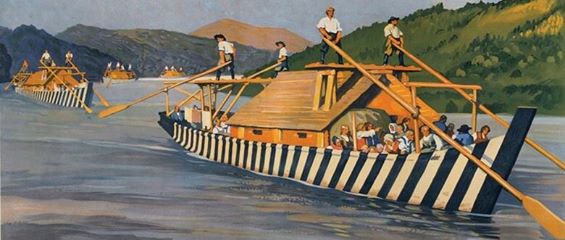
The Danube Swabian Foundation of the U.S.A., Inc.
Die Donauschwaebische Stiftung der USA, Inc.
OUR DANUBE SWABIAN ANCESTORS
by Anton Wenzel
Have you ever wondered why and how our ancestors migrated from Germany to Austria/Hungary, which later became Yugoslavia in part? Well, I did, so I did a lot of research about it and would like to share in brief form, what I found.
First of all, we need to go back in history to the Battle of Vienna in 1683, where it all started for us, when the forces of the Ottoman Empire threatened to wipe out Christianity in Europe and especially the Holy Roman Empire – also known as the Habsburg Empire – as well the kingdom of Poland. The map illustrates Europe in about 1700.

MEHMET HOLY WAR PLEDGE
Graced with the in heaven reigning God, we Mehmet, glorious and almighty Caesar of Babylon and Judea, from orient to occident. King of all earthly and heavenly kings, King of Arabia and Mauritania, born and glory crowned King of Jerusalem, master and ruler of the grave of the crucified God of the infidel. YOU, Caesar of Rome (meant is the Emperors of the Holy Roman Empire of German Nation), and YOU King of Poland, OUR holy word we pledge. May it be known also to all of your followers, that we are about to overrun your little country and bring with us 13 Kings and
1,300,000 troops, on foot and on horseback. We will destroy your little country with our Army of which neither you nor your subjects had knowledge of and stamp out all of them with our hoofs and deliver them to the flames and swords without act of grace or merci. Above all WE order you, to wait for us in your city residence, so WE can behead you; you little kingdom of Poland do the same. We will exterminate you and all of your followers, as you are the lowest creatures of God, as all unbelievers are, and erase you from the face of the earth. WE will expose the big and little to
gruesome pains first and than give them to a vicious death. Your little Empire, I will take from you and its entire population I will sweep off the earth. WE will let you and the King of Poland live long enough to witness and until you are convinced, that we have done all what we have pledged. This is done in recognition of the 40th Year of our live and in the 26th year of our almighty reign.”
This was the declaration of war that in 1683 Sultan Mehmed IV sent to Emperor Leopold I, when he recognized, what he thought was an opportunity to conquer the Christian civilizations. The original can still be seen in the Vienna archives. Before the Turkish army approached Vienna, Leopold I, and his family fled to Passau, Germany and a messenger was sent to the king of Poland, Jan III Sobieski. The two countries had signed a mutual protection treaty against the Ottoman Empire in March of 1683. If the Turks attacked either Krakow or Vienna, the other partner in the treaty was obligated to come to the aid. On July 14, 1683, the Turks arrived at Vienna with a substantially smaller army than threatened – about 250,000 men, and began to lay siege to the city. King Sobieski and the Polish army arrived in Vienna in early September and joined forces with the Germans and Austrians. The battle, under the leadership of the king of Poland, was an amazing victory; at the cost of 500 men they had inflicted the loss of 30,000 men and captured the sultan’s harem, 87 cannons, the royal treasure chest and the state seal of the Ottoman Empire. The main Ottoman army was scattered and the Austrians gained complete freedom of action.
The year 1687 saw the Turks leaving the Batschka. During their retreat the plundered and destroyed almost all the existing communities in the region and took the inhabitants into slavery. During a site inspection in 1698 it was found that more than 153 sites of former communities were completely destroyed and deserted. So the Monarchy decided to resettle the land with people from areas in Southwestern Germany. It was no coincidence that the Monarchy targeted the Swabians for solicitation to become settlers in the region. The Swabians were known to be industrious farmers and were of the preferred Catholic Faith. The Danube Swabians, got their start as a group back in 1712, when the first German settlers arrived in Sathmar, Hungary. After that, the first large scale migration or trek of Germans during the rule of Emperor Karl I took place between 1722-1726, when the settlers were granted tax exemptions and inheritance rights. Under the leadership of Maria Theresa and her son Joseph II, the settlement of the Banat made enormous progress
during the Second (1763-73) and Third (1781-86) Swabian Treks. In spite of heavy early reverses, after a few years the Imperial Banat became the granary of Europe. In 1782 a new settlement patent (Ansiedlungspatent) was released which guaranteed freedom of mind and religion for all citizens, and a house and a garden for every family, as well as a ten-year long tax exemption was guaranteed, along with various other perks. It should be noted though that these guarantees were not exactly a gift – each family needed 200 Gulden to qualify for this program, and the cost of building a house at that time was about 160 Gulden. There was another part to this agreement, which required the settlers to be part of a military border guard, to protect against incursions of Ottoman soldiers from time to time. Now, why would people leave their homeland for such an uncertain future? Well, one of the reasons was that inheritance laws in Germany were set up to protect the size of the family property, and therefore the oldest son had the right to inherit the farm undivided and his siblings received very little and had to work for their brother. They just wanted to escape serfdom. Also, Germany was over-populated. So, when the opportunity was offered to have their own land, many grabbed it with high hopes.
Instead of farmland, what awaited the newcomers often was swampland that needed to be drained before it could actually be tilled and become productive.
The trip to this “promised land” was not an easy one, as there was no established means of transportation, except for the Danube River. The trip started in Ulm, Germany, where wooden barges (called “Ulmer Schachtel”) – see the painting –
were constructed for the journey. Ulm, Germany was a gathering point for the settlers, were they took the barges first to Vienna, where they had to stop, register and be assigned to a new village, which had been planned there. Then, they continued their trip to their new homes. Once they arrived at their destination, the barges were disassembled and the lumber was used in building their first shelters.
